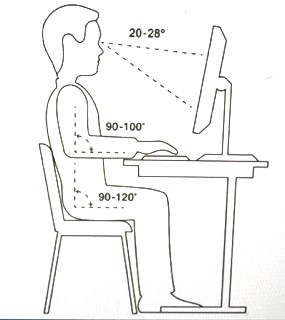
Ergonomics
Ergonomics is the study of people’s efficiency in their work environment. The position of your monitor, how you sit, how long you sit, and many other variables can affect your work efficiency. It is also important to consider the impact that working in front of a computer can have on your mental and physical health. Here are several suggestions for making your work environment more productive, enjoyable, and healthier.
Computer and Visual Ergonomics
- Choose a chair or standing position that supports your back. Make sure that you are not sitting for prolonged periods of time. Stretch your fingers, hands, and arms periodically.
- Be aware of your head tilting forward or backward as this can cause neck strain and headaches. Your computer display should be located just below eye height, about 4-5 inches as measured from the center of the monitor.
- When typing, make sure that your hands are at, or below your elbows. Your knees should be level with your hips.
- Position your computer monitor 20-28 inches away from your eyes.
- Refrain from prolonged periods of working on a mobile device, as this can create eye strain.
- After 2 hours of continuous computer use, rest your eyes for 15 minutes.
- Follow the “20-20-20 rule” to reduce eye strain: every 20 minutes, look at an object at least 20 feet away from your computer monitor for at least 20 seconds.
- Set the default font size on digital devices to 3.6mm.
- Use a blue-light filter on electronic devices to block the blue light emitted from digital screens.
Mental and Physical Health
- Move around during breaks and stand during conference calls to reduce your overall time spent sitting. A 2-3 minute activity break every 30 minutes has been shown to improve blood sugar health.
- Make time for a lunch break away from your desk. Plan 1 non work related lunch date per month.
- Set wellness boundaries between your work and personal life by keeping a regular work schedule and routine. Turn off your computer after hours.
- When working from home create a designated workspace separate from your living space as much as possible. When not working, close the door or hide your workspace using a partition.
- Your office should be comfortable. It should support feelings of ease and help create a smooth work flow. Have tools kept in your office that can help you decompress the body. Some suggestions are a yoga mat, foam roller, lacrosse ball or acupressure mat. Take mini breaks and use them.
- Use lamp lighting vs overhead lighting and an essential oil diffuser.
- Practice 2-3 minutes of deep breathing or mindfulness meditation a few times each day.
- Use a sound machine.
- Have a yearly Postural assessment done.
Call our office and schedule and appointment with one of our Health Coaches to learn more about ways to support a healthy mind and body while managing a robust work schedule.
Yours in health,
Clarissa A. Kussin, ND, FMHC, ERYT-1000

References:
1. Long J, Richter H. The pitfalls of the traditional office ergonomics model in the current mobile work environment: Is visual ergonomics health literacy the remedy? Work. 2019;63(3):447- 456. doi:10.3233/WOR-192937
2. Randolph SA. Computer Vision Syndrome. Workplace Health & Safety. 2017;65(7):328-328. doi:10.1177/2165079917712727
3. Chantal Coles-Brennan. Management of digital eye strain. Clin Exp Optom. 2019;102(1):18-29. doi.org/10.1111/cxo.12798
4. Dempsey PC, Larsen RN. Benefits for Type 2 Diabetes of Interrupting Prolonged Sitting With Brief Bouts of Light Walking or Simple Resistance Activities. Diabetes Care. 2016 Jun;39(6):964-72. doi: 10.2337/dc15-2336
5. Peddie MC, Bone JL. Breaking prolonged sitting reduces postprandial glycemia in healthy, normal-weight adults: a randomized crossover trial. Am J Clin Nutr. 2013;98(2):358-366. doi:10.3945/ajcn.112.051763
6. De Couck M, Caers R. How breathing can help you make better decisions: Two studies on the effects of breathing patterns on heart rate variability and decision-making in business cases. Int J Psychophysiol. 2019 May;139:1-9. doi: 10.1016/j.ijpsycho.2019.02.011.







